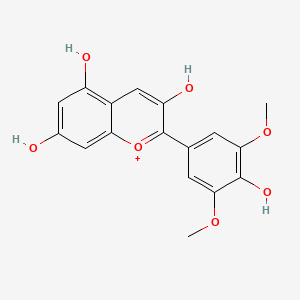
|
Malvidin |
Malvidin is a lipid of Polyketides (PK) class. The involved functions are known as conjugation. |
363 |
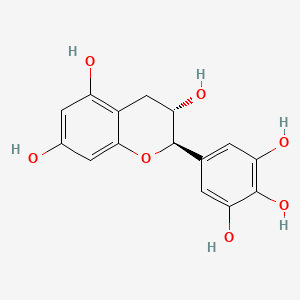
|
Gallocatechin |
(+)-gallocatechin is a lipid of Polyketides (PK) class. The involved functions are known as inhibitors and Cell Survival. The associated genes with (+)-Gallocatechin are TERT gene. |
778 |

|
(-)-Epicatechin gallate |
(-)-Epicatechin gallate is a lipid of Polyketides (PK) class. (-)-epicatechin gallate is associated with abnormalities such as Infection, trachomatis, Heart Diseases, Influenza and Hypoglycemia. The involved functions are known as Cell Proliferation, Metabolic Inhibition, Anabolism, protein expression and Apoptosis. (-)-epicatechin gallate often locates in Tissue membrane, Membrane, soluble, Plasma membrane and Protoplasm. The associated genes with (-)-Epicatechin gallate are GDF15 gene, ATF3 gene, CRISP2 gene, Homologous Gene and activating transcription factor 3. The related lipids are Lipopolysaccharides. The related experimental models are Cancer Model and Mouse Model. |
645 |
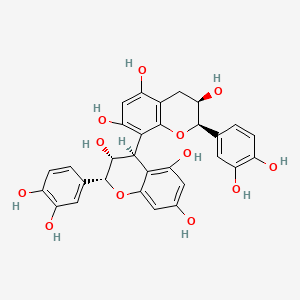
|
Procyanidin B2 |
Procyanidin B2 is a lipid of Polyketides (PK) class. The involved functions are known as conjugation, Methylation, Excretory function, enzyme activity and sulfatase activity. Procyanidin b2 often locates in Blood, Epidermis and Upper Gastrointestinal Tract. The associated genes with Procyanidin B2 are NR5A2 gene, HRAS wt Allele, CFB gene, PTGS2 gene and MAPK8 gene. |
205 |

|
(-)-Epigallocatechin gallate |
(-)-Epigallocatechin gallate is a lipid of Polyketides (PK) class. (-)-epigallocatechin gallate is associated with abnormalities such as IMMUNE SUPPRESSION, Infection, Nodule, Lymphopenia and Tumor Immunity. The involved functions are known as Apoptosis, Cellular Immune Response, Specific immune response, Signal and Infiltration. (-)-epigallocatechin gallate often locates in Immune system, Cytoplasmic Granules, Skin, Protoplasm and Body tissue. The associated genes with (-)-Epigallocatechin gallate are C8orf4 gene, Genes, vpr, MAPK8 gene, P4HTM gene and GAG Gene. The related lipids are Promega, Lipopolysaccharides, Palmitates, Fatty Acids and Sphingolipids. The related experimental models are Mouse Model, Xenograft Model, Transgenic Model, Experimental Autoimmune Encephalomyelitis and Arthritis, Collagen-Induced. |
6551 |

|
(-)-Epigallocatechin |
(-)-Epigallocatechin is a lipid of Polyketides (PK) class. The involved functions are known as Protective Agents, inhibitors, Process, Drug Kinetics and Fermentation. (-)-epigallocatechin often locates in Hepatic, Blood, Membrane, Back and apical membrane. The associated genes with (-)-Epigallocatechin are ADRBK1 gene and FASTK Gene. The related lipids are 1,2-dilinolenoyl-3-(4-aminobutyryl)propane-1,2,3-triol. The related experimental models are Rodent Model and Transgenic Model. |
1282 |
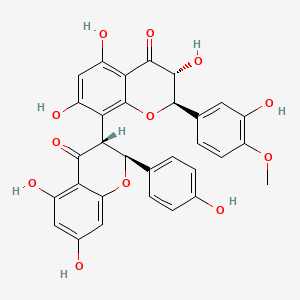
|
Kolaflavanone |
Kolaflavanone is a lipid of Polyketides (PK) class. Kolaflavanone is associated with abnormalities such as Diabetes, Hyperglycemia and Diabetic Nephropathy. The involved functions are known as Lipid Peroxidation, cholesterol biosynthetic process, Process, Excretory function and Apoptosis. Kolaflavanone often locates in Renal Tissue and Kidney - Cortex - Glomerulus (MMHCC). The associated genes with Kolaflavanone are Serum Albumin and TNF gene. The related lipids are Total cholesterol. |
125 |

|
SCHEMBL105486 |
Kakonein is a lipid of Polyketides (PK) class. Kakonein is associated with abnormalities such as Fatty Liver, Chronic liver disease, Morphologically altered structure, Hypertensive disease and Cardiovascular Diseases. The involved functions are known as protein expression, Extravasation, Liver damage, mRNA Expression and cell activation. Kakonein often locates in Body tissue, Hepatic, Microvilli, Cytoplasm and Membrane. The associated genes with Kakonein are TJP1 gene, CD14 gene, iberiotoxin, AT-Rich Interactive Domain-Containing Protein 1A and NKS1 gene. The related lipids are dehydrosoyasaponin I and Steroids. The related experimental models are Knock-out. |
1391 |

|
daidzein |
daidzein is a lipid of Polyketides (PK) class. Daidzein is associated with abnormalities such as Cardiovascular Diseases, Osteoporosis, Heart Diseases, Thyroid Diseases and Exanthema. The involved functions are known as Cell Growth, Disease Progression, metaplastic cell transformation, Cell Cycle and M Phase Cell Cycle Arrest. Daidzein often locates in Urothelium, Mucous Membrane, Chromosomes, Epithelium and Ribosomes. The associated genes with daidzein are Tumor Suppressor Genes, Genome, TIRAP gene, TICAM2 gene and Candidate Disease Gene. The related lipids are Promega, Steroids, Saponins, enterodiol and linoleates. The related experimental models are Xenograft Model, Knock-out, Mouse Model, Breast Cancer Model and Arthritis, Experimental. |
4463 |
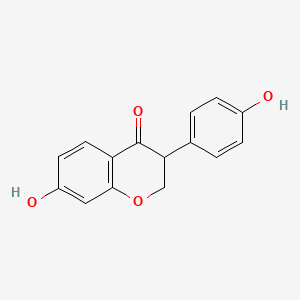
|
dihydrodaidzein |
dihydrodaidzein is a lipid of Polyketides (PK) class. Dihydrodaidzein is associated with abnormalities such as Bacteremia, Little's Disease and Postmenopausal syndrome. The involved functions are known as Metabolic Process, Cellular, racemization, Cytokinesis, enzyme mechanism and Stereochemistry. Dihydrodaidzein often locates in Cell-Free System, Face, Blood, Back and Cytoplasm. The associated genes with dihydrodaidzein are HOXA10 gene and tryptones. The related lipids are enterodiol. |
338 |
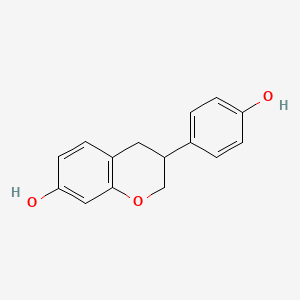
|
94105-90-5 |
94105-90-5 is a lipid of Polyketides (PK) class. 94105-90-5 is associated with abnormalities such as Fish-Eye Disease, Congenital uterine anomaly, Endometriosis, site unspecified, IMMUNE SUPPRESSION and Immune System Diseases. The involved functions are known as Anabolism, Ingestion, Signal Pathways, Phenomenon and Excretory function. 94105-90-5 often locates in brush border membrane, Entire gastrointestinal tract, Mouse Intestine, Body tissue and Skin. The associated genes with 94105-90-5 are GLUCOSIDASE, WASF1 gene, NPRL3 gene, FATE1 gene and AT-Rich Interactive Domain-Containing Protein 1A. The related lipids are butyrate, enterodiol, Steroids, Promega and Fatty Acids. The related experimental models are Mouse Model, Rodent Model, Knock-out, Disease model and Animal Disease Models. |
1223 |
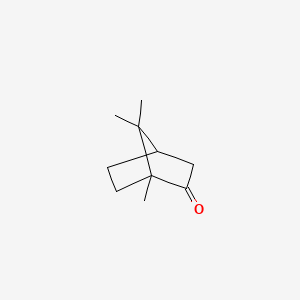
|
(+)-Camphor |
(+)-camphor is a lipid of Prenol Lipids (PR) class. (+)-camphor is associated with abnormalities such as Athetoid cerebral palsy. The involved functions are known as inhibitors, Synthesis, Feedback and Competitive inhibition. The associated genes with (+)-Camphor are 4S-limonene synthase. The related lipids are palmitoleic acid, pentadecanoic acid, stearic acid and erucic acid. |
3660 |
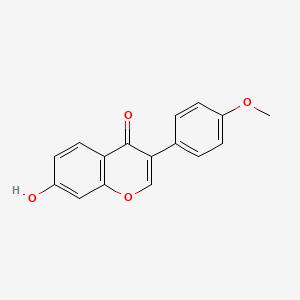
|
formononetin |
Formononetin is a lipid of Polyketides (PK) class. Formononetin is associated with abnormalities such as Infection, Dehydration, Mycoses, Consumption-archaic term for TB and Syndrome. The involved functions are known as Protein Overexpression, Methylation, Esthesia, Anabolism and enzyme activity. Formononetin often locates in soluble, Cytoplasmic matrix, Body tissue, Membrane and Tissue membrane. The associated genes with Formononetin are IMPACT gene, GLUCOSIDASE, Genes, Reporter, IGKV1-16 gene and GAL gene. The related experimental models are Knock-out. |
790 |
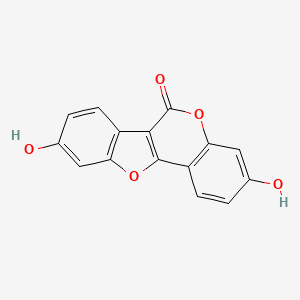
|
COUMESTROL |
COUMESTROL is a lipid of Polyketides (PK) class. Coumestrol is associated with abnormalities such as Infertility, Renal tubular disorder, Osteoporosis, Postmenopausal, Nodule and Central precocious puberty. The involved functions are known as Process, antagonists, Accident due to exposure to weather conditions, physiological aspects and Cell Proliferation. Coumestrol often locates in Blood, Body tissue, Reproductive system, Membrane and Myometrial. The associated genes with COUMESTROL are GAPDH gene, PPID gene, pyridinoline, NODAL gene and Nitrogen fixation gene. The related lipids are enterodiol. The related experimental models are Mouse Model. |
638 |
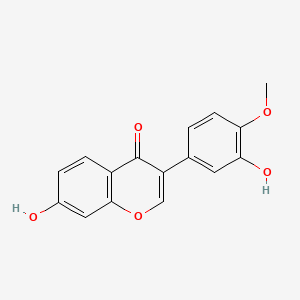
|
Calycosin |
Calycosin is a lipid of Polyketides (PK) class. Calycosin is associated with abnormalities such as Degenerative polyarthritis and Ischemia. The involved functions are known as Biosynthetic Pathways, Process, Anabolism, trans-cinnamate 4-hydroxylase activity and Transcription, Genetic. Calycosin often locates in viral nucleocapsid location, Mucous Membrane and Cell membrane. |
195 |
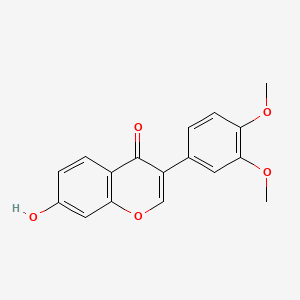
|
cladrin |
cladrin is a lipid of Polyketides (PK) class. |
9 |
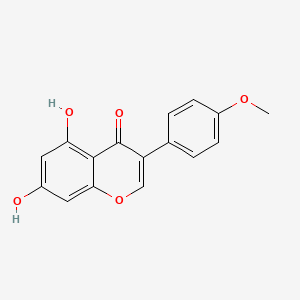
|
biochanin A |
Biochanin a is a lipid of Polyketides (PK) class. Biochanin a is associated with abnormalities such as Osteoporosis. The involved functions are known as Uptake, adenosinetriphosphatase activity, inhibitors, Drug Interactions and Metabolic Inhibition. Biochanin a often locates in Membrane, Tissue membrane, Microsomes, Microsomes, Liver and Entire oral cavity. The associated genes with Biochanin A are CD9 gene, SLCO1B1 gene, ABCG2 gene, EDNRB gene and SPAG8 gene. The related lipids are Steroids, Androstenols, Sphingolipids and 1,2-oleoylphosphatidylcholine. |
465 |

|
rotenone |
rotenone is a lipid of Polyketides (PK) class. Rotenone is associated with abnormalities such as Parkinson Disease, MYOPATHY, DISTAL, WITH ANTERIOR TIBIAL ONSET, Neurodegenerative Disorders, Septicemia and Respiratory Failure. The involved functions are known as Phosphorylation, Process, Cell Death, proteasome activity and Apoptosis. Rotenone often locates in Protoplasm, Presynaptic Terminals, Neurites, NADH dehydrogenase complex and Mitochondria. The associated genes with rotenone are DNAJB9 gene, EIF2S3 gene, Candidate Disease Gene, G-substrate and ERN1 gene. The related lipids are Lipopolysaccharides, Membrane Lipids, Phosphatidylserines, Fatty Acids and Cardiolipins. The related experimental models are Knock-out, Mouse Model, Disease model and Rodent Model. |
7079 |
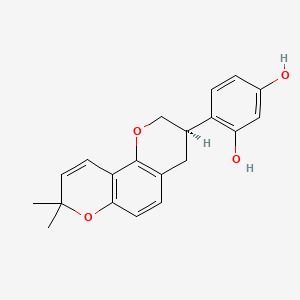
|
Glabridin |
Glabridin is a lipid of Polyketides (PK) class. Glabridin is associated with abnormalities such as Atherosclerosis, CNS disorder, Corn of toe, Fatty Liver and Obesity. The involved functions are known as Energy Absorption, Oxidation, Oxidants, Metabolic Process, Cellular and Drug Interactions. Glabridin often locates in Hepatic, membrane fraction, Microsomes, Microsomes, Liver and Extracellular. The associated genes with Glabridin are P4HTM gene, SPEN gene, SLC33A1 gene, ABCB1 gene and CD9 gene. The related lipids are Nonesterified Fatty Acids, Total cholesterol, Lipopolysaccharides, Hydroxycholesterols and 7-ketocholesterol. The related experimental models are Mouse Model. |
263 |

|
HEMATOXYLIN |
HEMATOXYLIN is a lipid of Polyketides (PK) class. Hematoxylin is associated with abnormalities such as Eosinophilia, Duodenal Adenoma, Senile Plaques, Morphologically altered structure and Cervical abscess. The involved functions are known as Uptake, Apoptosis, Amplification, Necrosis and Karyopyknosis. Hematoxylin often locates in Body tissue, Extracellular, Compact bone, Skin and Basement membrane. The associated genes with HEMATOXYLIN are GAPDH gene, Genome, Elastin, MERTK wt Allele and P4HTM gene. |
6127 |



















